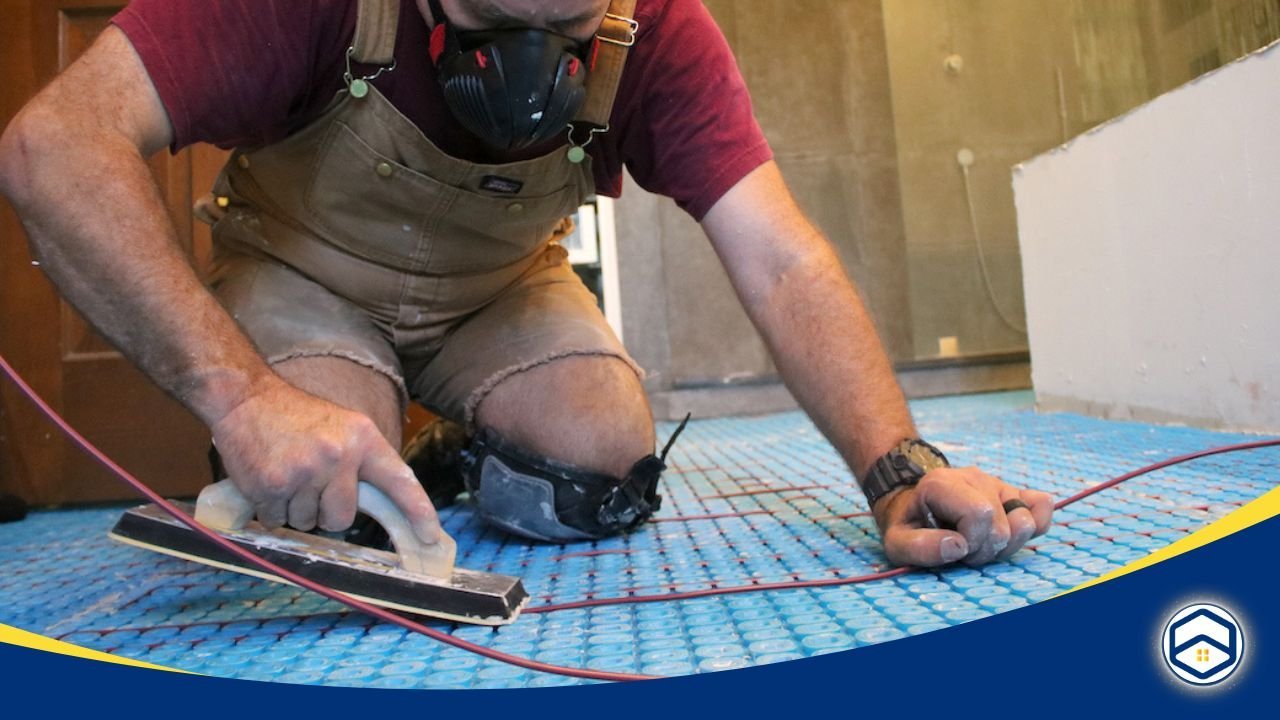In recent years, electric floor heating has gained immense popularity as a modern, efficient, and luxurious way to heat homes and buildings. This guide will delve into the details of electric floor heating, exploring its benefits, installation process, costs, and more. Whether you’re a homeowner considering this upgrade or a builder looking to understand its advantages, this comprehensive guide will cover everything you need to know about electric floor heating.
What is Electric Floor Heating?

Electric floor heating, also known as radiant floor heating, involves installing a heating element beneath the flooring to provide warmth from the ground up. Unlike traditional heating systems that rely on convection to warm the air, electric floor heating uses radiation to directly heat surfaces and objects in the room, creating a more comfortable and evenly distributed warmth.
Benefits of Electric Floor Heating
Choosing to install electric floor heating in your home comes with a multitude of advantages, making it an appealing option for modern homeowners.

- Energy Efficiency: Electric floor heating systems are highly energy-efficient. They operate at lower temperatures compared to conventional heating systems, which reduces energy consumption and can lead to significantly lower utility bills.
- Even Heat Distribution: Unlike forced-air systems, which can create hot and cold spots, electric floor heating provides consistent warmth throughout the entire floor area, ensuring a uniformly comfortable environment.
- Space-Saving: Because the heating elements are installed under the floor, there is no need for bulky radiators or vents. This allows for more flexible interior design and furniture placement, making electric floor heating a practical and stylish choice.
- Improved Air Quality: Electric floor heating does not circulate dust and allergens as forced-air systems do, making it a healthier option for people with allergies or respiratory issues. The absence of moving air contributes to a cleaner and more pleasant indoor environment.
- Quiet Operation: These systems operate silently, eliminating the noise associated with traditional heating systems. With electric floor heating, you can enjoy a peaceful and serene home without the constant hum of a furnace or blower.
- Increased Home Value: Adding electric floor heating can increase the resale value of your home, as it is seen as a modern and desirable feature. Potential buyers often appreciate the added comfort and efficiency, making your property stand out in the market.
Types of Electric Floor Heating Systems
There are several types of electric floor heating systems, each offering unique advantages suited to different installation scenarios and user needs.

- Electric Radiant Heat Mats: Electric floor heating mats are pre-sized and often come with a convenient mesh backing. This design makes them easy to install, particularly in larger, regularly shaped rooms. The mats ensure a uniform distribution of heat, making them an efficient choice for spacious areas. With electric floor heating mats, you can enjoy the benefits of quick installation and consistent warmth throughout your home.
- Loose Cable Systems: For those seeking greater flexibility, loose cable systems are an excellent option. These electric floor heating systems are perfect for rooms with irregular shapes or for targeting specific areas within a room. The cables can be spaced according to the required heat output, providing a customized heating solution. This adaptability makes loose cable systems a versatile choice for any electric floor heating project.
- Floor Heating Films: Floor heating films are another innovative electric floor heating solution. These thin, flexible films are ideal for installations under laminate, engineered wood, or vinyl flooring. They are less intrusive than other heating systems, making them perfect for retrofit projects where space is at a premium. With electric floor heating films, you can easily upgrade your existing floors to incorporate modern, efficient heating technology.
Installation Process
The installation of electric floor heating involves several detailed steps to ensure a successful and efficient setup. Here’s a breakdown of the process:
- Planning and Design: The installation process for electric floor heating begins with meticulous planning and design. This initial step involves designing the layout and calculating the heating requirements to ensure optimal performance. Key considerations include determining the size of the area to be heated, the type of flooring, and the heat loss of the room. Proper planning ensures that the electric floor heating system is tailored to your specific needs, providing efficient and effective warmth.
- Preparation: Preparation is crucial for a successful electric floor heating installation. The subfloor must be clean, dry, and level to ensure proper adhesion and function of the heating elements. Insulation boards can be installed to enhance efficiency by reducing heat loss, ensuring that the warmth generated by the electric floor heating system is directed upwards into the living space rather than being lost through the subfloor.
- Installing Heating Elements: The core of the electric floor heating system involves installing the heating elements. Depending on the type of system chosen—whether mats, cables, or films—these elements are laid out according to the design plan. It’s essential to follow the manufacturer’s guidelines for spacing and installation to ensure even heat distribution and prevent any potential issues. Proper installation of the heating elements is key to the overall performance of the electric floor heating system.
- Connecting to Power Supply: Once the heating elements are in place, the next step is to connect the electric floor heating system to the electrical supply. This often involves a dedicated circuit to handle the power requirements safely. Additionally, a thermostat is installed to control the temperature, allowing you to adjust the heat to your desired comfort level. Proper electrical connections are critical to the safe and efficient operation of the electric floor heating system.
- Flooring Installation: After the heating system is thoroughly tested and confirmed to be functioning correctly, the final flooring can be installed over the heating elements. This could include tiles, laminate, wood, or other types of flooring suitable for electric floor heating. The choice of flooring will impact the heat transfer efficiency and the overall performance of the system.
- Final Testing: The last step in the installation process of electric floor heating is the final testing. Once the flooring is in place, a comprehensive test ensures that the system operates correctly and efficiently. This step verifies that the electric floor heating system provides consistent and reliable warmth, confirming that the installation has been successful and that the system is ready for use.
Costs of Electric Floor Heating
The cost of electric floor heating can vary widely depending on several factors:

- System Type:The type of electric floor heating system you choose significantly impacts the cost. Mats and films tend to be more affordable and easier to install, making them a popular choice for many homeowners. On the other hand, loose cable systems can be more expensive due to their higher flexibility and customization options. These systems allow for tailored installations that can fit irregularly shaped rooms or specific heating needs, but this added versatility comes at a higher price.
- Area Size: The size of the area you intend to heat plays a crucial role in determining the total cost of electric floor heating. Larger areas require more materials, which naturally increases both material and installation costs. For instance, a small bathroom may only need a single mat, while a large living room might require multiple mats or extensive cable systems, thus raising the overall expense..
- Flooring Type: The type of flooring you have or plan to install over your electric floor heating system also affects the cost. Some flooring materials, like tile or stone, are more compatible with electric floor heating and may not require additional modifications. Conversely, other types of flooring, such as certain types of wood or carpet, might necessitate extra preparation or materials to ensure optimal heat transfer and system performance, leading to higher costs.
- Labor Costs: Professional installation is recommended to ensure that your electric floor heating system is set up correctly and safely. While this adds to the overall cost, it guarantees that the system operates efficiently and reduces the risk of installation-related issues. Labor costs can vary based on the complexity of the installation, the region you live in, and the professional’s expertise.
On average, the cost of installing electric floor heating ranges from $5 to $15 per square foot, including materials and labor. Operating costs are relatively low due to the system’s efficiency, but they can vary based on usage and local electricity rates.
Maintenance and Longevity
Electric floor heating systems require minimal maintenance. Regularly checking the thermostat and ensuring the system is functioning correctly is usually sufficient. These systems are highly durable and can last for several decades if installed correctly. However, any damage to the heating elements typically requires professional repair.
Safety Considerations

Electric floor heating is generally safe, but it’s important to follow all installation guidelines and local building codes. Using a ground fault circuit interrupter (GFCI) is recommended to protect against electrical shocks. Additionally, proper insulation and spacing of heating elements prevent overheating and potential fire hazards.
Conclusion
Investing in electric floor heating is not just about enhancing comfort – it’s about creating a healthier, more energy-efficient living space that can increase the value of your home. With this comprehensive guide, you are now equipped with all the information you need to make an informed choice about electric floor heating.











